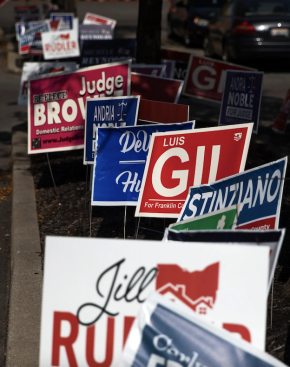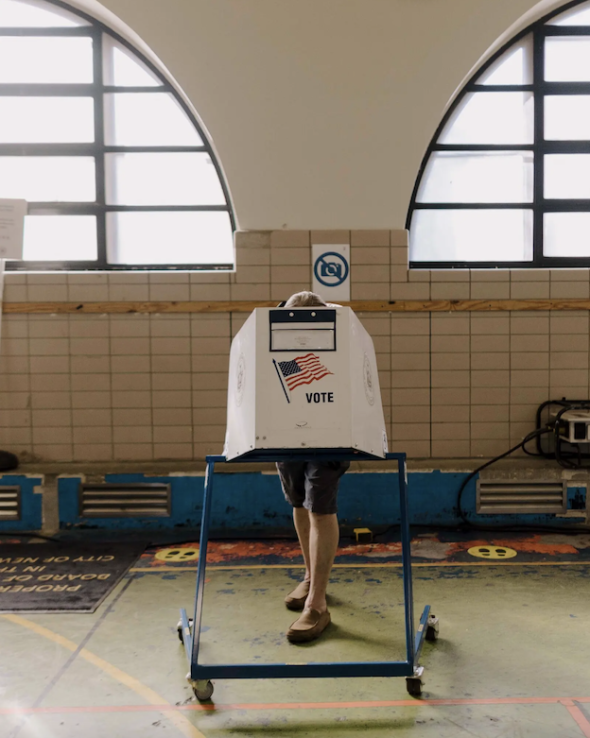Does America Vote Too Much?
 Campaign signs in Columbus, Ohio. Maddie McGarvey for The New York TimesAmericans casting their ballots in tomorrow’s midterm elections might be voting in their 30th or 40th contest in four years. In the same amount of time, a German citizen might vote in six to eight races.
Campaign signs in Columbus, Ohio. Maddie McGarvey for The New York TimesAmericans casting their ballots in tomorrow’s midterm elections might be voting in their 30th or 40th contest in four years. In the same amount of time, a German citizen might vote in six to eight races.
Put simply, the U.S. has an unusually high number of elections. The federal government alone holds elections every two years, compared with around every four or five years in other advanced democracies.
Why does this matter? Some experts argue that the saturation of elections has significant downsides — exhausting voters and hurting the quality of governance by pushing lawmakers toward more campaigning, fund-raising and short-term thinking.
But more frequent elections also offer voters more opportunities to hold officials accountable. Experts characterized elections as a balancing act: Too many can overwhelm the public and lawmakers, while too few provide insufficient chances for accountability.
“It’s not about whether democracy is good or bad, but how we manage democracy,” said Sarah Anzia, a political scientist at the University of California, Berkeley. “The question is if these systems are leading to the government doing a good job and doing the things that we want it to do.”
In today’s newsletter, I will explain why America votes so frequently and why other countries take a different approach.
Frequent elections
The U.S. is an outlier in two ways: the frequency of its elections and the number of government positions that are elected, said Larry Jacobs, a political scientist who has analyzed election trends in the U.S. and other countries.
In other countries, parliamentary democracies typically hold elections every four or five years. Those that have elections more frequently are typically suffering political crises. (Israel, for example, held its fifth election in less than four years last week and voted to restore the previous prime minister, Benjamin Netanyahu, to power even as he faces corruption charges.)
In the U.S., the federal government holds elections for Congress at least twice as often, every two years. More local and state elections are sometimes pegged to the federal races, but not in most cases.
Americans elect more than half a million officials in total, from president to county coroner. (It’s hard to compare this number to other countries, which might put more legislative seats to a vote but not, say, mine inspector or county engineer.) One example that’s particularly odd in a global context: “No other democracy in the world uses elections to pick judges or prosecutors,” said Richard Pildes, an elections expert at New York University. Instead, other officials typically appoint a country’s judges and prosecutors.
All of these elections can also sometimes require at least two rounds of voting, in both party primaries and general elections. In other countries, party leaders typically pick their party’s candidates, instead of relying on primaries, as my colleague Max Fisher explained.
 Early voting in Brooklyn last week. Ahmed Gaber for The New York Times
Early voting in Brooklyn last week. Ahmed Gaber for The New York Times
Unintended consequences
How did the U.S. become so vote-happy? In part, it goes back to progressive activists’ push in the early 20th century to make America more democratic, experts said. The activists of the time believed that frequent elections would give the public a greater voice and keep citizens politically engaged. Over decades, they pushed local and state governments to put more offices to voters and to hold elections more frequently.
But the changes might have had the opposite effect to the one that activists sought.
For one, the number of elections can overwhelm voters, prompting them to sit out races. Turnout for local elections often sinks below 25 or even 15 percent. And even in federal races with high turnout, U.S. voters participate at a lower rate than many other democracies, including Australia, Germany and France. (Experts cautioned that the abundance of elections is just one factor in these trends.)
“Reformers often think that the average citizen is as interested and engaged and focused on political matters as the reformers are,” Pildes said. “But that’s unrealistic.”
In this way, more elections can produce a less democratic outcome: With fewer voters casting ballots, the resulting government is less representative of the full population. “This is actually distorting our democracy by putting in candidates that don’t reflect majority opinion,” Jacobs said.
The frequency of elections also pushes lawmakers toward extensive campaigning. Congressional leaders have indicated that they want to pass several major bills before 2023 — to fund the government, protect same-sex marriage rights and improve election security, among other issues. Yet Congress recessed a month ago to give legislators time to campaign for tomorrow’s elections.
Lawmakers also tend to prioritize short-term issues, knowing that they and their party only have two years to act before they face voters again. In other advanced democracies, governing parties typically get four to five years to implement their full agenda and show voters the effects before elections.
Moving to a system of less frequent elections might make the U.S. seem less democratic in its governing processes, advocates of the change acknowledged. But if fewer elections boost participation and engagement, they said, the country could become more democratic in its outcomes.
Article originally published by The New York Times at 7/11/2022